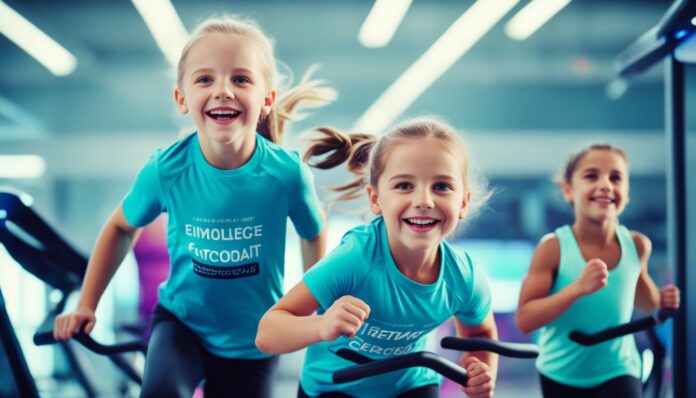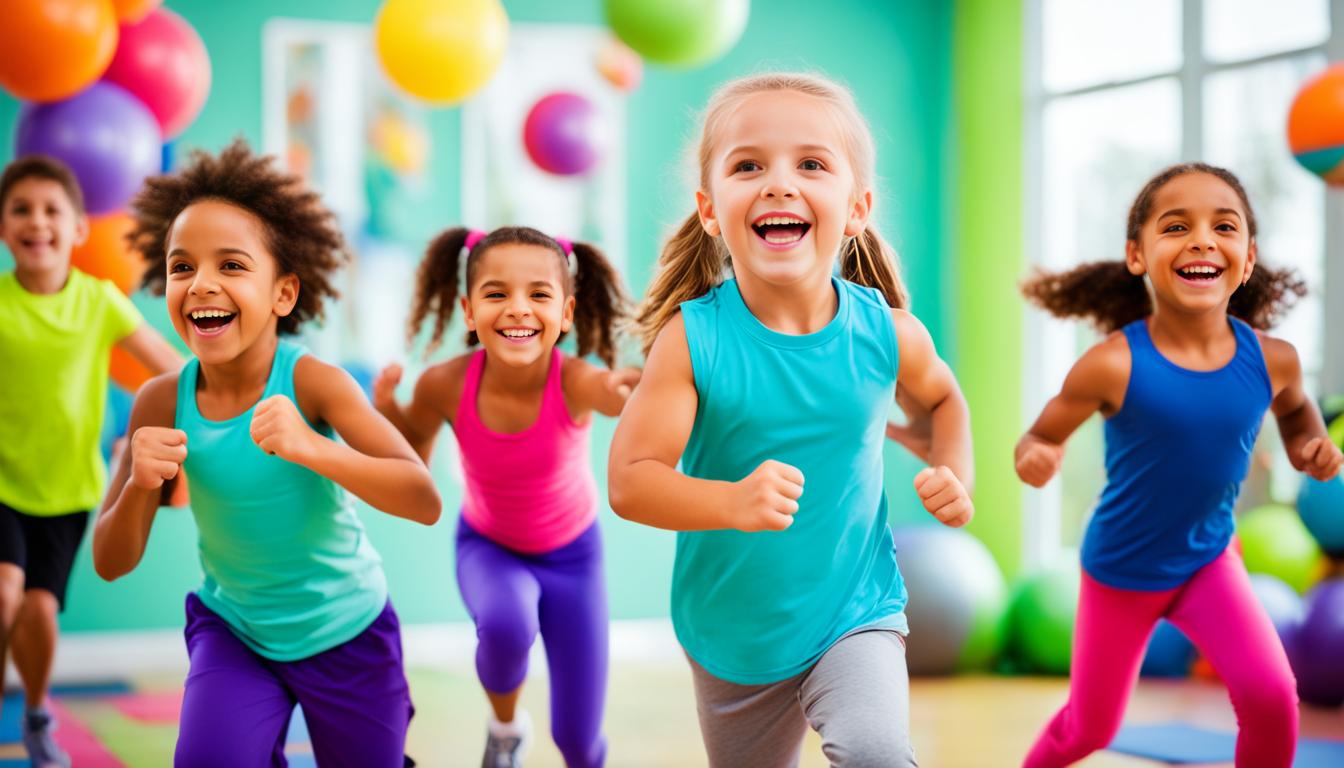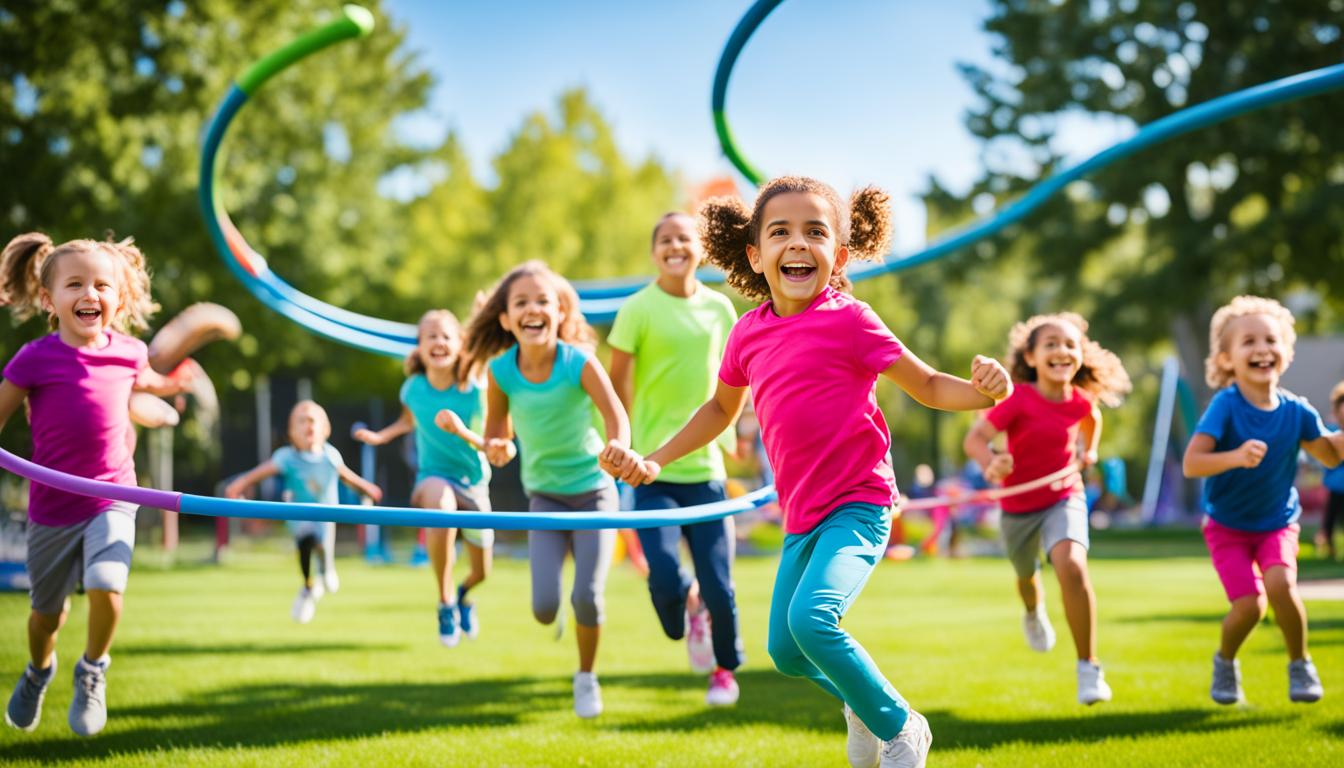
Since 1966, the President’s Council has pushed for more youth fitness through the Youth Fitness Test. Yet, kids with disabilities are 4.5 times less active than others. This shows we need new ways to motivate kids to work out in 2025.
We must work together to inspire kids to be fit. Every child should get to enjoy the perks of being active. This is key for their health and happiness.
In 2025, we dream of a world where kids can easily find fun workouts. These activities will help them grow strong in body and mind. Let’s make a place where kids feel motivated to exercise and reach their full potential.
Key Takeaways
- The President’s Council’s Youth Fitness Test has emphasized the need for youth fitness since 1966.
- Engagement in physical activity is crucial for children, particularly for those with disabilities.
- Innovative programs like ROX provide practical tools for empowerment and encourage fitness among girls.
- Funding and community support play vital roles in establishing youth fitness programs.
- A collective effort is needed to address the barriers affecting youth participation in physical activities.
- Fostering a supportive environment is essential for building children’s confidence and engagement in fitness.
The Importance of Physical Activity for Kids
Physical activity is key for our kids’ health and happiness. It boosts their fitness and overall well-being. Kids who exercise do better in school and make friends easier.
Sadly, most teens don’t get enough exercise. But, exercise helps kids in many ways, both in body and mind. Adding fun to workouts makes kids want to stay active and feel less stressed.
Being active helps kids feel emotionally strong and resilient. It’s more important now than ever, after the COVID-19 pandemic. Teaching kids to love exercise now means they’ll be healthier adults later. This leads to a happier, more active community for everyone.
Understanding Children’s Fitness Inspiration
Getting kids to stay active can be tough, but knowing what motivates them helps a lot. It starts with seeing what makes kids want to move more. By letting kids take control of their fitness, we help them develop healthy habits for life.
Factors Affecting Children’s Fitness Motivation
Many things help kids want to be more active. Important ones include:
- Parental Support: Kids do better when parents are active and invite them to join in.
- Peer Engagement: Being active with friends makes kids more likely to keep moving.
- Accessible Spaces: Having safe places to play and exercise is key.
- Autonomy in Activity Selection: Letting kids pick their activities makes them more into it.
In California, schools have to offer two gym classes a day. This helps kids stay active during important years. We should keep pushing for more physical education, inspired by thinkers like John Dewey.
Only 24% of U.S. kids get enough exercise each day. Events like National Physical Fitness and Sports Month can spark kids’ interest in staying active.
| Age Group | Daily Caloric Needs | Recommended Physical Activity |
|---|---|---|
| 2 Years | 1,200 calories | Outdoor play 60-90 minutes |
| 3-5 Years | 1,200 calories | Outdoor play 60-90 minutes |
| 6 Years and Older | Varies by individual needs | At least 1 hour of moderate to vigorous activity |
We can get kids more into fitness by focusing on what motivates them. By understanding what drives their activity, we can help them have healthier lives.
Workout Motivation for Kids 2025: Strategies for Success
In 2025, we aim to inspire our youth with creative methods. These methods will keep physical fitness fun and engaging for them. Setting clear goals is crucial. When kids know what they’re working for, they get more motivated.
Personalized fitness plans let each child find activities they love. This makes exercise feel like a fun adventure, not a task. Using technology, like fitness apps for kids, can also boost motivation. These apps track progress and offer challenges that spark friendly competition.
Adding fun fitness activities can lift kids’ spirits. Dancing, team sports, or martial arts can make exercise exciting. Kids do well in social settings. So, organizing friendly competitions or family workouts can boost motivation and strengthen relationships.
Reward systems help keep kids motivated. Celebrating their achievements, big or small, keeps them excited and involved. With the right approach and support, we can help our kids develop active habits for life.
Kid-Friendly Physical Activity Boosters
Encouraging our children to be active can change their health and happiness. By adding fun to their daily routines, we can make kid-friendly exercises exciting. Using different physical activity ideas for kids makes fitness fun, helping them develop good habits for life.
Creative Ways to Make Fitness Fun
Let’s look at some fun ways to boost kids’ fitness and make them excited. Creative strategies can turn fitness into an adventure:
- Interactive Games: Games like freeze tag or scavenger hunts mix play with movement. They’re great for getting heart rates up and having fun.
- Sports Variations: Add fun twists to sports, like obstacle courses or relay races, to traditional games. This encourages kids to join in.
- Outdoor Adventures: Nature walks, bike rides, or hiking are great for fitness and love for nature.
- Family Fitness Outings: Plan weekend activities like swimming, roller skating, or visiting parks for lots of active play.
- Dance Parties: Host dance-offs at home to different music. It’s a fun way for kids to stay active without it feeling like work.
These fun ideas help us boost kids’ fitness and make physical activity positive. Let’s make happy memories that keep children active and healthy for life.
Engaging Young Athletes through Fun Challenges
Fostering young athlete engagement is key to making kids love fitness for life. Using fitness challenges for children grabs their attention and gets them moving. Friendly competitions and team activities build a sense of togetherness, making kids excited to join in.
These challenges teach kids about sportsmanship and help them start good fitness habits. Schools and communities can host events where kids can compete and have fun at the same time. Offering different challenges helps kids of all skills feel proud of their efforts.
Using strategies like motivating kids in sports through teamwork makes their experience better. Activities like pre-game huddles bring athletes, coaches, and parents together, creating a supportive community. Encouraging kids to support each other in different sports helps them make friends and feel proud of their peers.
These fun activities motivate kids to love fitness, make friends, and grow into strong individuals. Let’s work together to make a place where every child wants to join in and do well.
Strategies for Energizing Juvenile Workouts
Keeping our kids active is key for their health and happiness. Fun workouts make exercise a part of their daily life. By trying different activities, kids stay interested and find what they love. This variety helps them love staying active for life.
Incorporating Variety into Children’s Exercise Routines
Here are ways to make workouts fun and engaging for kids:
- Introducing New Sports: Letting kids try various sports helps them find what they like. Each sport teaches new physical skills.
- Dance Classes: Dance is a fun way to get kids moving. Styles like hip-hop, ballet, or Zumba make exercise fun.
- Outdoor Adventures: Outdoor activities like hiking, biking, or playing at the park connect kids with nature and keep them active.
- Fitness Games: Games that involve movement, such as tag or obstacle courses, make exercise a fun challenge.
Adding these fun elements to their workouts helps kids see physical activity as important. These strategies are key to building habits that last a lifetime.

Motivating Movement in Children: Best Practices
We know that getting kids to move is key. We must be actively involved. Celebrating their small wins keeps them excited about physical activities. This makes them want to keep reaching their fitness goals.
It’s important for kids to keep moving regularly. Fun activities like dance are great for their health. Dance boosts fitness, emotional strength, and even helps in school, making it a top way to encourage kids to move.
Creating a supportive environment makes kids see moving as fun. As parents, we set the example by being active. This encourages our kids to do the same.
Strength training is a great way to get kids moving too. For kids over seven, start with light weights and supervision. Short, regular workouts can boost their strength and health.
Activities like jungle gym play are also key for kids. They help with fitness and social skills. Kids learn to be confident, lead, and work together as they play.
Following these best practices helps kids develop healthy habits for life. We can help them enjoy moving and look forward to a happy, active future.
Fostering Active Lifestyles for Kids
We can make a big difference in kids’ health by creating chances for them to be active. Working with local groups helps us get kids moving every day. This makes being active a normal part of their lives.
Creating Community Engagement Opportunities
There are many ways to help kids stay fit. Local sports clubs and after-school fitness programs are key. They offer fun activities that get kids moving.
These groups help kids try out different sports and activities. They also help kids make friends. Events like fitness festivals and sports leagues make kids feel like they belong. They get to see and try new things.
For example, a “Kids Fun Run” or a family sports day can make exercise fun. This mix of fun and fitness gets kids excited about staying active.
Schools play a big role too. Adding physical education to the school day means kids move more. Schools can also offer after-school programs and safe places for kids to play during breaks.
Studies show we need to get kids moving more. The World Health Organization says kids should do at least 60 minutes of exercise every day. By creating fun community programs, we can fight sitting too much and keep kids healthy.
| Community Initiative | Benefits |
|---|---|
| Local Sports Organizations | Encourage teamwork and skill development |
| After-School Fitness Programs | Provide structure and consistent activity |
| Community Fitness Events | Foster community spirit and participation |
| School Physical Education Programs | Enhance knowledge and practice of various sports |
Working to get kids active can lead to healthier lives. By focusing on fitness, we help kids take charge of their health. This way, they can do well in all areas of life.
Creating Youthful Exercise Incentives
We know how important exercise incentives for kids are to get them excited about moving. By setting up fun reward systems, we can get them to join in and make exercise a blast. These rewards help kids want to be active and develop a love for it.
Setting clear goals is key to getting kids pumped up. Celebrating their wins along the way keeps them motivated towards their fitness goals. For example, they might get a special outing or activity after reaching a goal, like being active for a certain number of days.
Motivational rewards for youth can be many things, such as:
- Sports gear or cool gadgets.
- Healthy snacks after a workout.
- Fun events with friends to show that exercise is a team effort.
Research shows that kids enjoy exercising with others, like friends or family. This shows how important it is to have fun together. Activities like biking or dancing become more enjoyable when done with others. Bob Swepstone talks about how exercising with friends makes it both fun and effective.

Getting the whole family involved in sports or planning active vacations helps everyone bond over fitness. Many families make exercise fun by doing things like hula hooping or swimming together. Upbeat music can also make workouts more exciting, keeping kids energized.
Being part of community charity events adds another reason for kids to stay active. These events let kids exercise while helping others. By making physical activities fun, we help kids develop good habits that last a lifetime.
| Incentive Type | Description | Example |
|---|---|---|
| Reward Systems | A way to celebrate kids’ achievements in being active. | Weekly challenges with prizes for the winners. |
| Social Events | Activities for kids to exercise with their friends. | Group bike rides or team sports. |
| Healthy Treats | Rewards for kids after they exercise. | Fruit smoothies after a workout. |
| Community Events | Getting kids involved in local fitness events or fundraisers. | Fun runs or charity walks. |
In short, combining exercise incentives for kids with fun activities keeps them committed to being active. By offering different rewards, we make sure they keep enjoying physical activity as they grow.
Building Supportive Communities for Fitness
Creating a vibrant and supportive community is key for kids’ fitness. These communities help active families work together, showing that teamwork boosts health for our youth. By supporting fitness together, kids get motivated to move with their friends and family.
Enhancing Family Involvement
Family support greatly affects kids’ health and school success. Studies show that active parents lead to better grades, higher self-esteem, and healthier choices. We can boost this support by making schools welcoming for families and improving communication between teachers and parents.
- Implement programs that promote volunteer opportunities for parents in wellness initiatives.
- Utilize surveys and focus groups to understand parents’ needs and barriers to participation.
- Host workshops and health fairs to educate families about wellness initiatives.
Building fitness communities strengthens ties between schools, families, and local groups. This creates a support network. Programs like School Wellness Councils help everyone work together. They bring together schools, families, and groups to push for healthier habits.
Supporting active families helps everyone. For instance, a parent giving ten hours a month is worth nearly $300. This builds a culture of teamwork and shared effort. It’s especially helpful for families in need, who might not have many resources. Together, we can make a big difference in wellness and fitness for all kids.
A community focused on kids’ well-being lays a strong base for a future where fitness comes first. We inspire the next generation to be active, healthy, and take part in their lives. By supporting fitness together, we build a culture of active living. This creates strong bonds and a lively community spirit.
Conclusion
As we conclude our look at workout motivation, let’s think about the key points we’ve covered. Chronic diseases cause 7 out of 10 deaths in the U.S., showing we need to act fast for our kids’ health. By helping kids stay motivated to work out, we’re not just focusing on fitness. We’re also helping them avoid early death, injuries, and chronic diseases.
We aim for a world where every kid loves to stay active. This matches up with the WHO’s Global Action Plan for Physical Activity. Being active helps fight against sitting too much and boosts grades and mental health. As parents and teachers, we can make sure our kids live healthier, more active lives. This will also cut down on healthcare costs and chronic disease.
We all have the power to push for an active life that values fitness. By joining this effort, we can raise a generation that sees physical health as important. Together, we can build a future where kids are fit, confident, and ready to face challenges. We can make a world where kids take charge of their health and do well in every part of life.
FAQ
Why is workout motivation important for kids in 2025?
Encouraging kids to work out is key for their health and happiness. It helps them stay fit, do well in school, and make friends. Starting fitness habits early sets them up for a healthy life as they grow.
How can we foster children’s fitness inspiration?
We can inspire kids to be active by letting them choose their own activities. Supporting them and having friends to exercise with helps too. Making places easy to move around in and trying out different exercises makes them excited about fitness.
What strategies can keep kids engaged in physical activities?
To keep kids moving, we can set goals they can reach and use fitness apps. Fun challenges with friends and making fitness plans just for them helps too. This makes them want to stay active.
How can we make physical activity fun for kids?
Make exercise fun with games, outdoor fun, and creative challenges. Turning workouts into adventures makes fitness something to look forward to, not a task.
What role do community programs play in promoting physical activity for kids?
Community programs like sports teams and after-school clubs help kids be more active. They offer a place to make friends and support each other in staying fit.
How can families support an active lifestyle for children?
Families can lead by example and exercise together. Having a regular exercise routine shows kids that moving is part of life. This encourages them to be active too.
What are some creative exercise incentives for youth?
Creative ways to motivate kids include team challenges and rewards for reaching fitness goals. Competing with friends makes exercise fun and helps them feel proud of their efforts.
How can we ensure inclusivity in fitness programs for children?
To make fitness programs welcoming for everyone, involve families and focus on teamwork. Offer activities for all interests and abilities. This creates a place where every kid feels they belong.
